
Blechnaceae is a family of ferns in the order Polypodiales, with a cosmopolitan distribution. Its status as a family and the number of genera included have both varied considerably. In the Pteridophyte Phylogeny Group classification of 2016, the family has 24 genera, and excludes genera placed in the separate family Onocleaceae. Alternatively, it may be treated as the subfamily Blechnoideae s.l. of a very broadly defined family Aspleniaceae, and include genera others place in Onocleaceae.

This is a list of taxa comprising the flora of the Antipodes Islands. It includes some species known as megaherbs.
Blechnum petiolare is a species of fern in the family Blechnaceae. It is endemic to Ecuador and known only from Bolívar Province. When it was first described in the early 20th century, it was known from Chillanes but this area has been heavily disturbed and the species continues to be threatened.
Austroblechnum divergens, synonyms including Blechnum divergens, Blechnum rimbachii and Blechnum floresii, is a species of fern in the family Blechnaceae.
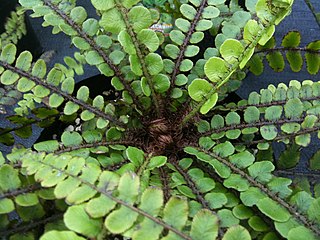
Cranfillia fluviatilis, synonym Blechnum fluviatile, is a fern known in the Māori language as kiwikiwi. A herbaceous plant, C. fluviatilis is a "hard fern" of the genus Cranfillia in the family Blechnaceae. It was identified by Patrick Brownsey in 1979. Other common names are star fern, creek fern, kawakawa and kiwakiwa.
Austroblechnum leyboldtianum, synonym Blechnum blechnoides, known as iquide in Chilean Spanish, is a fern species endemic to Chile.
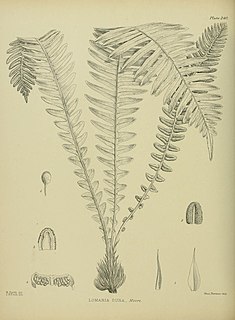
Austroblechnum durum, synonym Blechnum durum, is a species of fern in the family Blechnaceae. The fern is endemic to New Zealand.

Austroblechnum lanceolatum, synonym Blechnum chambersii, is a species of fern within the family Blechnaceae, found in Australia, New Zealand, Samoa and Fiji.
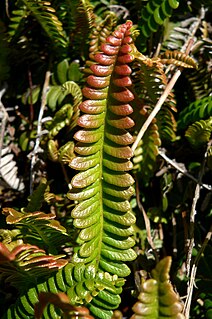
Austroblechnum penna-marina, synonym Blechnum penna-marina, known as Antarctic hard-fern, alpine water fern and pinque, is a species of fern in the family Blechnaceae, with a natural range from the Araucanía Region to the south and from the coast to the tree line of the Magellanic forests in Chile and adjacent areas of Argentina. It is also found in New Zealand, Australia and some Pacific islands. It is evergreen and grows to 20 cm (8 in).

Luteolinidin is a chemical compound belonging to the 3-deoxyanthocyanidins and that can be found in Sorghum bicolor.
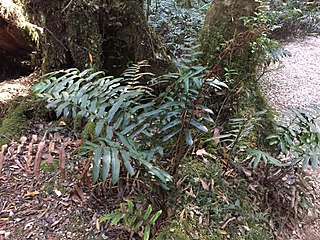
Parablechnum wattsii, synonym Blechnum wattsii, is a common terrestrial fern growing in rainforest and open forest. It is often seen near creeks in much of south eastern Australia, including Victoria, Tasmania, South Australia, New South Wales and Queensland. The specific epithet wattsii honours William Walter Watts (1856-1920). Watts was considered an authority on mosses and ferns and has more than 30 species named for him. Common names by which the species may be called are hard water fern - from its stiff leathery fronds, leech fern - as forest workers often encounter leaches while working in clusters of these ferns, hard hill fern - from the fern's habit and habitat, and red cabbage fern - from the bronze-pink colour of the young fronds resembling cooked red cabbage.
Kiokio is a Māori word that may refer to:
Victoria, Australia contains approximately 32,000 hectares of temperate rainforest in various regions, which represents 0.14% of the State's total area. The areas with rainforest include: East Gippsland, Strzelecki Ranges, Wilsons Promontory, Central Highlands, and Otway Ranges. The rainforests vary between cool temperate, warm temperate, and mixed cool temperate.

Austroblechnum patersonii, synonym Blechnum patersonii, is a fern in the family Blechnaceae. It is known as the strap water-fern.
Blechnum Peaks are three peaks, the highest 640 metres (2,100 ft) high, on the north-south ridge between Gulbrandsen Lake and Olsen Valley on the north coast of South Georgia. They were named by the UK Antarctic Place-Names Committee, following British Antarctic Survey biological work in the area, after the rare fern Blechnum penna-marina, whose occurrence in South Georgia is known only from the north and east slopes of these peaks and from the adjacent Olsen Valley.

Telmatoblechnum indicum or the swamp water fern is often seen growing on sandy soils in swampy areas. The specific epithet indicum is from Latin, revealing this plant was first collected in the East Indies (Java). Indigenous Australians used the starchy rhizome as food.
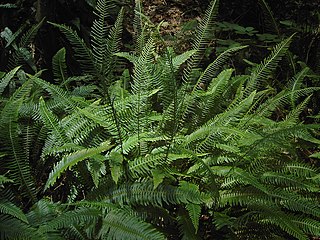
Struthiopteris is a genus of ferns belonging to the family Blechnaceae, subfamily Blechnoideae.

Austroblechnum colensoi, synonym Blechnum colensoi, also known as Colenso's hard fern, waterfall fern or peretao is a species of fern native to New Zealand. It is distributed throughout the North, South and Stewart Islands.

Austroblechnum is a genus of ferns in the family Blechnaceae, subfamily Blechnoideae, according to the Pteridophyte Phylogeny Group classification of 2016. The genus is accepted in a 2016 classification of the family Blechnaceae, but other sources sink it into a very broadly defined Blechnum, equivalent to the whole of the PPG I subfamily.












